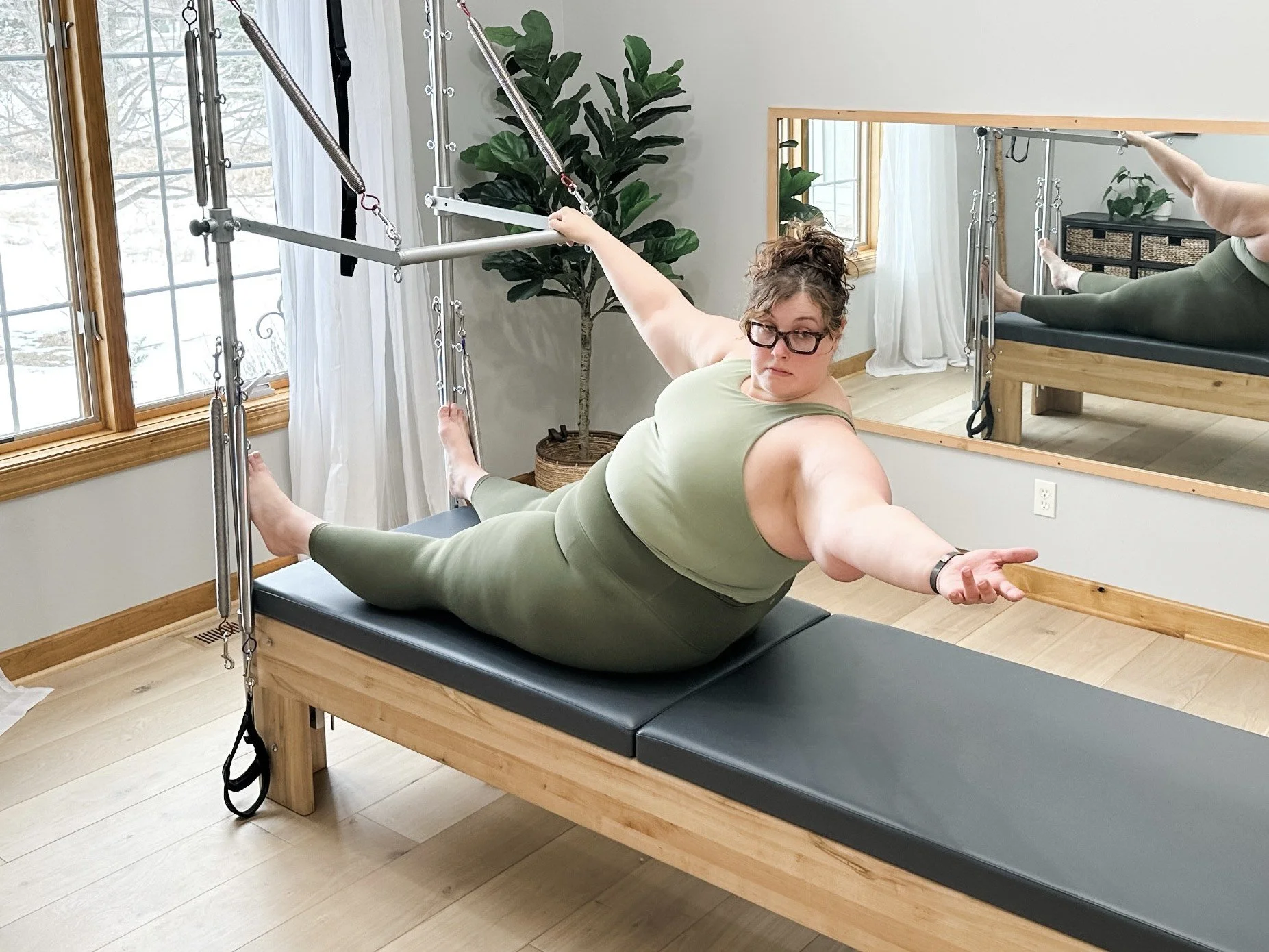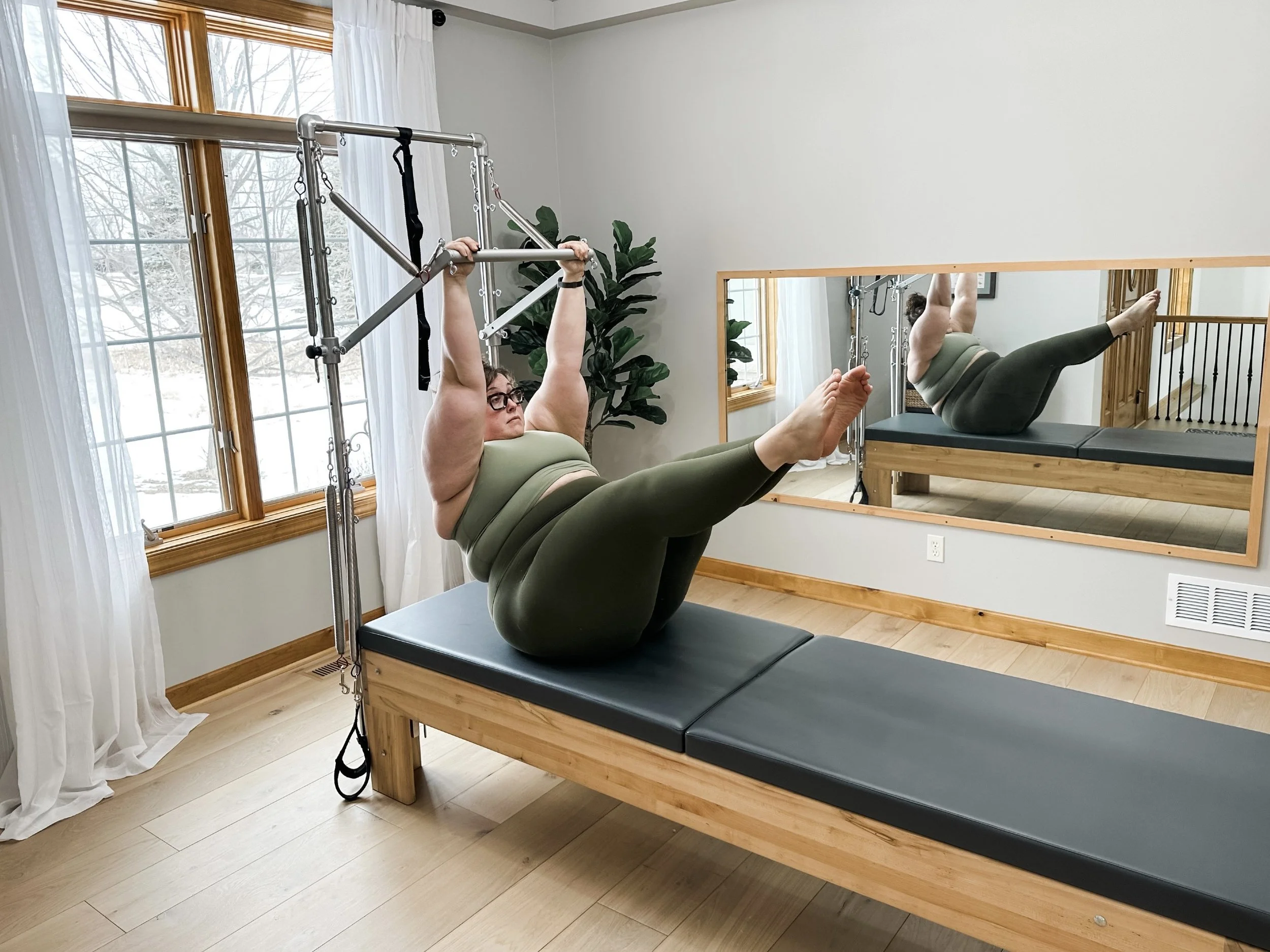Pilates has a size inclusivity problem
I say this as someone who has been practicing for almost a decade and recently completed comprehensive teacher training. All in a larger body.
Since I first walked into a studio, not a single instructor has acknowledged my body (in a non-judgmental way anyway—certainly I’ve been the target of the skeptical top to bottom and back again visual assessment followed by a grimace). Nor has anyone been able to offer straightforward suggestions about what I can do differently to get the most out of my practice. And if I think back, the only thing my teacher training taught me specifically about larger bodies is what exercises are contraindicated for us, as if our size alone is all you need to know to judge our capabilities.
This is bad. Not only from a social justice lens, but also from a business model perspective. (And to be clear, that statement isn’t to suggest that we should prioritize cashflow over the humanity of our clients. Rather, it is meant to illustrate that there are multiple benefits to addressing this issue head on.) So why is the Pilates industry still so willing to ignore such a significant and growing portion of its potential client base?
The answer is anti-fat bias. Our society has conditioned us to believe that the size of someone’s body is an indication of their morality, of their goodness and value as a human being. And this sets the stage for intolerance and oppression. Nobody, not even those of us in larger bodies ourselves, is exempt from participating in this discrimination. Nor is anyone, regardless of the size of their body, immune to the negative impacts of this ubiquitous prejudice.
Once we accept this reality and take responsibility for the part we have played in perpetuating this false and harmful narrative, we begin to see where opportunities lie for us to do better moving forward. We can create accepting and accessible spaces for bodies of all sizes to practice Pilates.
To facilitate acceptance, as Pilates practitioners and/or instructors, as participants in the fitness industry, and, frankly, as members of the human race:
· We must stop speaking negatively about bodies. All bodies are good bodies.
· We must stop suggesting that bodies need to change. All bodies are deserving of respect and care as they are.
· We must stop praising weight loss. This not only reinforces the problematic message that smaller bodies are better bodies, but if we don’t know why someone has lost weight, we may be praising disordered habits or serious health conditions.
· We must stop discussing diets or the need to earn food. These conversations are outside the scope of a Pilates instructor and can contribute to disordered thought patterns and behaviors. All bodies deserve to not only fuel themselves adequately, but also find joy in food. There is comfort and culture and community in food, and we all deserve to experience that without guilt.
· We must stop making assumptions about someone’s goals, habits, or abilities based on the size of their body. The size of someone’s body tells you absolutely nothing about them or what they are capable of.
“But I can’t control other people!” This is true. But we do have the ability to set boundaries. Especially if it is our class and/or studio. We are allowed to create rules and ask that all individuals adhere to them to ensure that our space is as safe as possible for everyone to practice in. Because practicing—admitting that we have room to improve—is inherently vulnerable. This is especially true for folks in larger bodies who rarely see themselves represented in Pilates and fitness spaces and, completely understandably, may already feel anxious simply for showing up.
In addition to creating an accepting space, we must also understand that making a class accessible to clients in larger bodies doesn’t just mean making the class easier. It means considering the ways our bodies may move differently through an exercise or interact differently with props or apparatus and providing options that accommodate these differences in an equitable way. After all, our clients are all paying for our classes. It’s our job as instructors to make sure they’re all getting what they paid for, not regardless of, but because we are honoring the size of their bodies.
Often this means providing options when cueing setup (including the use of props and/or allowing for adjustments to “standard” spring settings), execution, and progression, and allowing the client to choose what is best for them in the moment. And if they make a bad call… well, nobody forgets the time they tried to do something on too light a spring and almost face planted.
Trusting clients to (safely) experiment, learn, process, and apply that knowledge going forward is how we build their skills to advocate for themselves. Allowing them to advocate for themselves ensures that they are getting exactly what they need from their practice, without requiring an unsustainable amount of labor (physical, intellectual, emotional) from us as instructors. It allows them, rightly, to be the experts on their own bodies and helps them rebuild the trust and confidence in themselves, their bodies, and our industry that society has led us to believe they do not deserve.
But we do deserve it. Everyone deserves it. Because Pilates is for all bodies.
Lindsey Leaf (she/her) has been practicing Pilates since 2015 and completed comprehensive teacher training through Balanced Body in 2021. She has been advocating for improved representation and inclusion of larger bodies in the Pilates industry since 2019 via her @fatbodypilates Instagram account.


